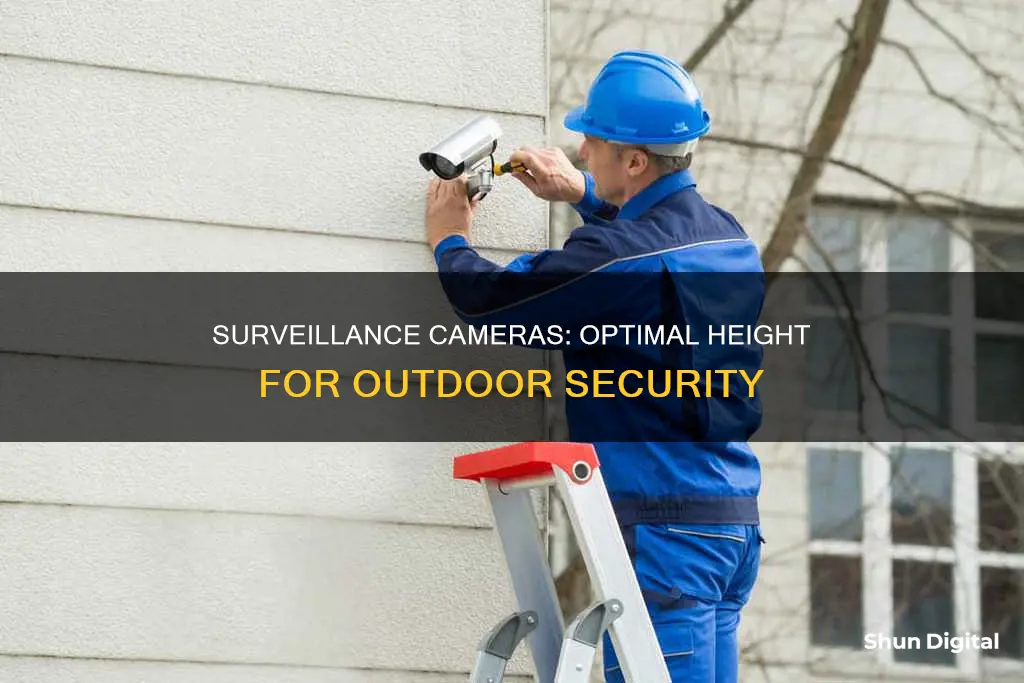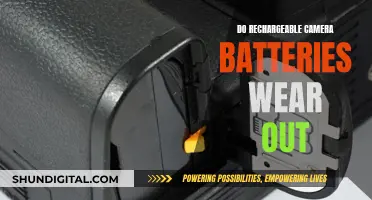
The height of outdoor surveillance cameras is a critical factor in effective monitoring and security. While the optimal height may vary depending on the specific use case and property type, there are some general guidelines to consider. Most security companies recommend installing cameras at a height of around 8 feet. This height strikes a balance between safety and security, as it protects the cameras from vandals while providing adequate field coverage. However, some homeowners opt for a height of 16 feet, which offers a wider field of view, especially for cameras with long focal lengths.
In addition to height, other factors such as angle, field of view, and lighting conditions also play a role in the effectiveness of outdoor surveillance cameras. For instance, mounting a camera too high may result in insufficient lighting at night, affecting its ability to capture clear images or videos.
| Characteristics | Values |
|---|---|
| Optimal height for capturing surroundings | 5m (16 feet) |
| Optimal height for a balance between safety and security | 2.5m (8 feet) |
| Optimal height for facial recognition | 5-6 feet |
| Optimal height for license plate recognition | 3-4 feet |
| Optimal height for capturing a general view of the surroundings | 2.5m (8 feet) |
| Optimal height to avoid lightning damage | 9 feet |
| Optimal height for indoor cameras | 10ft or higher |
| Optimal height for cameras in manufacturing and warehouse settings | 10-12 feet |
| Optimal height for cameras at entrances and exits | 7 feet |
What You'll Learn

Cameras should be high enough to avoid vandalism
To avoid vandalism, outdoor surveillance cameras should be placed out of arm's reach. Typically, a height of nine feet is recommended as it makes it difficult for vandals to reach and tamper with the cameras. However, the optimal height may vary depending on the specific location and susceptibility to lighting. For example, in manufacturing and warehouse settings, the ideal height for security cameras is between 10 and 12 feet as it provides a broader view and supports operational oversight.
To further protect your outdoor security cameras from vandalism, consider the following:
- Use vandal-resistant housing: Vandal-proof housings are made from robust, impact-resistant materials like heavy-duty metal and reinforced plastic. The IK rating scale indicates the level of protection, with IK00 offering no protection and IK10 the highest level of protection against impacts.
- Secure the wiring: Burying the wires or protecting them in conduit makes it harder for vandals to find and cut the cables.
- Implement tamper alarms: Some advanced cameras have tamper detection features that send instant alerts if the cameras are moved or vandalized.
- Install security lights: Motion-activated lights can deter potential vandals and improve the effectiveness of the cameras.
- Use dummy cameras: Installing fake cameras can act as a deterrent and confuse vandals, keeping them focused on neutralizing the dummy cameras while the real ones monitor the area.
- Place signs: Displaying signs indicating that the area is under surveillance can act as a deterrent.
By following these guidelines, you can help ensure that your outdoor surveillance cameras are high enough and well-protected to avoid vandalism.
Quickly Edit Multiple Photos in Camera Raw
You may want to see also

Height depends on the type of property
The height of outdoor surveillance cameras depends on the type of property and the purpose of the surveillance. Most security companies recommend installing cameras at a height of 2.5m (8 feet). This height strikes a balance between safety and security, protecting the cameras from vandals while providing adequate field coverage. However, the height may vary depending on the specific needs and constraints of the property owner.
For instance, in manufacturing and warehouse settings, the ideal height for security cameras is between 10 and 12 feet. This higher placement provides a broader view, supporting operational oversight across a wide area. In retail and office spaces, on the other hand, eye-level camera placement (around 5 to 6 feet) is recommended to capture faces and aid in identifying individuals in cases of theft or other incidents.
For homeowners, installing cameras at a height of 5m (16 feet) offers unique benefits. At this height, cameras can capture a wider area with an angle that points further away from the horizon, allowing them to see as far as possible. This setup is particularly advantageous for cameras with long focal lengths, as their lenses can effectively pick up images at long distances.
When considering the height of outdoor surveillance cameras, it's important to keep in mind that placing them too high can lead to several issues. The cameras may need to be tilted more than normal, reducing their reach and resulting in capturing heads instead of faces. Additionally, maintenance and service can become more difficult at very high heights.
On the other hand, installing cameras too low also presents challenges. The camera's view can be easily obstructed by people passing by, and the camera becomes more vulnerable to tampering or accidental movement. Therefore, finding the optimal height that balances security and effective surveillance is crucial.
Stealth Trail Cameras: What Batteries Do They Use?
You may want to see also

Cameras should be placed to avoid lightning damage
To protect your outdoor security cameras from lightning damage, it is recommended to avoid mounting them on isolated high points, such as the top of a building or pole. Instead, cameras should be placed lower on buildings, typically at a height of around 8 to 9 feet. This reduces their exposure to lightning strikes and potential damage.
Lightning strikes pose a significant threat to security cameras and can result in costly repairs or replacements. When a camera is struck by lightning, it can be destroyed, and the surge of electricity can also damage other connected devices, such as switches, recorders, routers, and NVRs. Therefore, it is crucial to take preventive measures to minimise the risk of lightning damage.
One effective way to protect your cameras is to ensure proper grounding. If your camera is mounted on a building, it should be grounded to the building's structural steel, as close as possible to the camera. A copper strap of approximately 1 to 1.5 inches in width can be used for grounding. This helps reduce the risk of a power surge travelling down the cable and damaging the connected equipment.
If your camera is mounted on a metal pole, it is essential to ground it to the pole itself and install a proper ground system at the base. Metal is a highly conductive material, making it more susceptible to lightning strikes. By grounding the camera to the pole, you provide a path for the lightning to discharge safely into the ground without damaging the camera or connected devices.
In addition to grounding, you can also consider using lightning-rated units or installing PoE surge protectors. Investing in high-quality cameras from trusted brands can provide better protection against power surges. PoE surge protectors regulate abnormal electrical currents and redirect excess currents to the grounding wire, protecting your cameras and connected devices from damage.
By following these measures—placing cameras lower on buildings, proper grounding, using lightning-rated units, and installing surge protectors—you can significantly reduce the risk of lightning damage to your outdoor surveillance cameras and protect your security system as a whole.
Charging Pentax Cameras: A Quick Guide to Powering Your Device
You may want to see also

Facial recognition cameras should be at face level
The height at which you install your security cameras is critical to effective surveillance. While there is no precise calculation or parameter to determine the ideal height, it is generally recommended that outdoor security cameras are installed at a height of around 2.5 metres (8 feet) to protect them from vandals while providing adequate field coverage. However, for facial recognition cameras specifically, a height of around 1.5 to 1.8 metres (5 to 6 feet) is ideal as it aligns the camera with the average human face level.
Facial recognition cameras should ideally be positioned slightly above eye level to reduce glare and shadows, which can interfere with recognition accuracy. This height ensures that the camera captures the faces of most individuals, providing clear and unobstructed images. If the camera is placed too low, the scene may be easily obstructed by other people, and the camera becomes more vulnerable to tampering or accidental movement.
Additionally, the height of a facial recognition camera should also consider the camera's resolution and dynamic range. Higher-resolution cameras can be placed at a greater height while still effectively capturing facial details. Conversely, lower-resolution cameras should be placed at a lower height to ensure clear images.
It is worth noting that in some cases, a combination of camera heights may be beneficial. For example, at entrances and exits, a higher camera (around 2.1 metres or 7 feet) can provide an overview, while a lower, eye-level camera captures facial details. This dual approach helps ensure a comprehensive record of all entrances and exits.
In conclusion, while the optimal height for outdoor security cameras varies depending on specific needs and constraints, facial recognition cameras should generally be installed at face level, around 1.5 to 1.8 metres (5 to 6 feet) above the ground, to optimise the accuracy of the technology.
Mastering the Art of Focusing Your Red Camera
You may want to see also

Camera height affects image quality
Secondly, the height of a camera can impact its vulnerability to vandalism and theft. A camera mounted too low can be easily tampered with or damaged, while a camera mounted too high may be out of reach but more susceptible to lightning damage. Therefore, finding the optimal height that balances security and image quality is crucial.
Thirdly, the height of a camera can affect its ability to capture clear and crisp images, especially at night. Each camera has a specific IR illuminating distance, and if mounted too high, it may not be able to illuminate its surroundings effectively, resulting in poor-quality footage. Additionally, zooming in on distant objects can pixelate the image, making it difficult to discern small details.
Lastly, the height of a camera can impact the performance of specialised functions such as facial and license plate recognition. For facial recognition, the ideal camera height is around five to six feet, aligning with the average human face level. For license plate recognition, a height of three to four feet is recommended to capture plates clearly and avoid headlight glare.
In summary, the height of a security camera has a significant impact on image quality and should be carefully considered to ensure optimal performance and effective surveillance.
Unlock Halo Reach Theater's Free Camera Mode
You may want to see also
Frequently asked questions
The ideal height depends on the purpose of the camera. For capturing facial details, a height of around 5-7 feet is recommended, while cameras aimed at monitoring a broader area should be placed higher, typically between 8-12 feet.
Yes, placing cameras at a higher height, such as 8-12 feet, can help to deter vandals and thieves by making the cameras more difficult to reach and tamper with.
One potential drawback is lightning damage. To minimize this risk, it is recommended to install cameras lower on buildings, typically around 8-9 feet, and avoid isolated high points.
The height of the camera can impact its field of view. A higher camera can capture a wider area but may miss important details due to the increased distance. A lower camera, mounted at 5-7 feet, can capture more detailed images, including facial recognition.
In addition to height, the angle and field of view of the camera are important factors. Wide-angle cameras can cover a larger area but may distort the image and capture fewer details. The lighting conditions and the intended purpose of the camera should also be considered when determining the optimal height.







